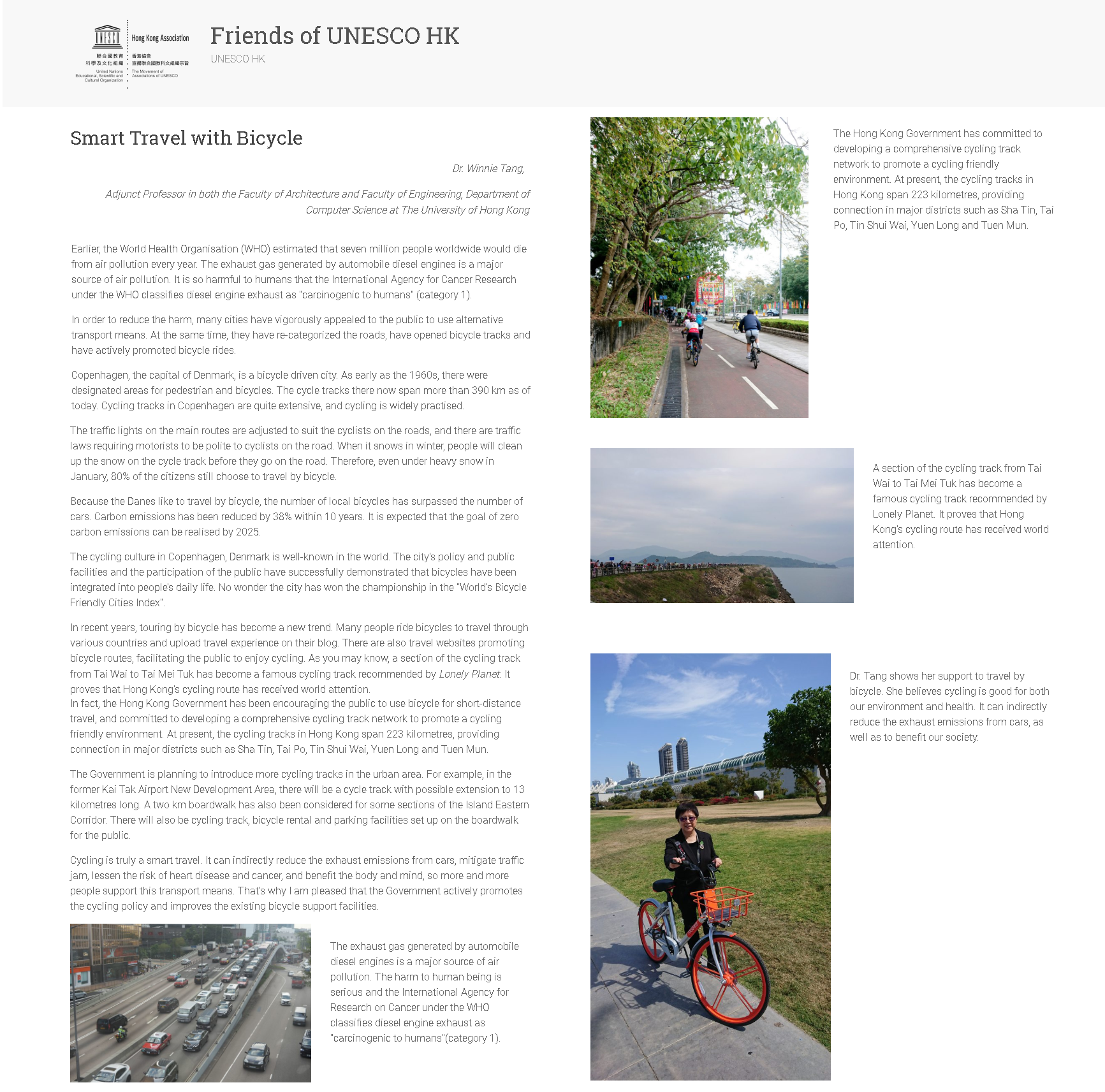網上版請按此

Smart Travel with Bicycle
Earlier, the World Health Organisation (WHO) estimated that seven million people worldwide would die from air pollution every year. The exhaust gas generated by automobile diesel engines is a major source of air pollution. It is so harmful to humans that the International Agency for Cancer Research under the WHO classifies diesel engine exhaust as “carcinogenic to humans” (category 1).
In order to reduce the harm, many cities have vigorously appealed to the public to use alternative transport means. At the same time, they have re-categorized the roads, have opened bicycle tracks and have actively promoted bicycle rides.
Copenhagen, the capital of Denmark, is a bicycle driven city. As early as the 1960s, there were designated areas for pedestrian and bicycles. The cycle tracks there now span more than 390 km as of today. Cycling tracks in Copenhagen are quite extensive, and cycling is widely practised.
The traffic lights on the main routes are adjusted to suit the cyclists on the roads, and there are traffic laws requiring motorists to be polite to cyclists on the road. When it snows in winter, people will clean up the snow on the cycle track before they go on the road. Therefore, even under heavy snow in January, 80% of the citizens still choose to travel by bicycle.
Because the Danes like to travel by bicycle, the number of local bicycles has surpassed the number of cars. Carbon emissions has been reduced by 38% within 10 years. It is expected that the goal of zero carbon emissions can be realised by 2025.
The cycling culture in Copenhagen, Denmark is well-known in the world. The city's policy and public facilities and the participation of the public have successfully demonstrated that bicycles have been integrated into people's daily life. No wonder the city has won the championship in the “World's Bicycle Friendly Cities Index”.
In recent years, touring by bicycle has become a new trend. Many people ride bicycles to travel through various countries and upload travel experience on their blog. There are also travel websites promoting bicycle routes, facilitating the public to enjoy cycling. As you may know, a section of the cycling track from Tai Wai to Tai Mei Tuk has become a famous cycling track recommended by Lonely Planet. It proves that Hong Kong's cycling route has received world attention.
In fact, the Hong Kong Government has been encouraging the public to use bicycle for short-distance travel, and committed to developing a comprehensive cycling track network to promote a cycling friendly environment. At present, the cycling tracks in Hong Kong span 223 kilometres, providing connection in major districts such as Sha Tin, Tai Po, Tin Shui Wai, Yuen Long and Tuen Mun.
The Government is planning to introduce more cycling tracks in the urban area. For example, in the former Kai Tak Airport New Development Area, there will be a cycle track with possible extension to 13 kilometres long. A two km boardwalk has also been considered for some sections of the Island Eastern Corridor. There will also be cycling track, bicycle rental and parking facilities set up on the boardwalk for the public.
Cycling is truly a smart travel. It can indirectly reduce the exhaust emissions from cars, mitigate traffic jam, lessen the risk of heart disease and cancer, and benefit the body and mind, so more and more people support this transport means. That's why I am pleased that the Government actively promotes the cycling policy and improves the existing bicycle support facilities.
Dr. Winnie Tang
Adjunct Professor in both the Faculty of Architecture and Faculty of Engineering, Department of Computer Science at The University of Hong Kong